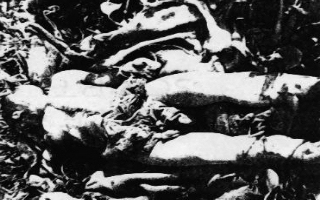| Home |
| CHT |
| Background |
| Bengali Settlers |
| Armed Resistance |
| Massacres |
| Genocide |
| Religious Persecution |
| Rapes & Abductions |
| Chakma Refugees |
| CHT Treaty |
| Foreign Aid |

|
On 2 February 1992 Bangladesh army backed Muslim settlers killed at least 30 indigenous Chakma Buddhists at Mallya. One of them was Shantibala Chakma, the wife of Mr. Saral Kumar Chakma. Two bombs exploded on a river ferry at Mallya. The explosion killed a passenger and seriously injured the skipper of the ferry. The survivors swam ashore but the armed Muslim settlers were waiting for them and attacked the indigenous Chakma Buddhists - men women and children. |
Bangladesh army massacre over 70 indigenous people in Matiranga
Prelude to Massacre
In the early months of 1986, law enforcement personnel raided indigenous villages in Panchari, Khagrachari and Dighinala area and a little further south in Naniachar and Mohalchari area in efforts to force the inhabitants to move to joutha khamars (collective farms, concentration camps).
Shanti Bahini declared its intention to obstruct polling in the Chittagong Hill Tracts at general elections due to be held throughout the country on 8 May 1986. Shanti Bahini had called upon the indigenous people to boycott the general election.
0n 29 April 1986, Shanti Bahini had attacked several Muslim settlements near the Indian border in Matiranga, Khagrachari district killing at least 38 Muslim settlers. 3 large groups of Shanti Bahini attacked BDR border outposts at Assalong, Chota Assalong and Taidong facing the border post of Bhagwantilla in India. This attack was the first of a number of operations launched by the Shanti Bahini over the next few months. Reprisals by Bangladesh army, BDR, Ansars and Muslim settlers began immediately after 29 April.
Massacre
Following the reprisal attacks described above many indigenous people from the affected areas sought refuge in the forests away from their homes. A few hundred people from several different villages gathered during the first week of May between the villages of Sarveswarpara and Manudaspara in the Matiranga, Khagrachari district. One night probably that of 1 or 2 May, while they were trying to reach the Indian border, they were ambushed by a detachment of Bangladesh army. The soldiers opened fire without warning and shot at them randomly, without provocation.
Over 70 people died in the massacre. Annesty International has compiled a list with the names of 15 of these people, identifying the villages from which they came. The names have been collected from several eye witnesses, but since the group of people ambushed came from many different villages, those who survived are only able to identify the residents from their own village whom they believe died. As can be seen from the list, many of those reported to have died were middle aged or elderly people.
The following is an eye witness account from a villager of Sarveswarpara, who fled fron his home after BDR troops and Muslim settlers had attacked and burned it on 1 May:
"We took to the jungles and hid there till the night. There we met hundreds of Chakmas who were running away. At night we tried to break out of the jungle to reach India but it seemed that someone had already informed the army about the route that we were going to take and there were soldiers waiting for us on the open ground and they began to fire at us. Several people died and I saw many falling around me but I kept running. There was no time to see how many had died. But it seems most of the people from my village survived."
From the description this man and others provided it seems that the firing may have been from an automatic weapon, possibly a light machine gun. Another villager stated:
"We ran into an army ambush. They were waiting for us with big big guns and it rained bullets (sic). I saw so many people getting shot as I ran and luckily survived."
A villager from Loganq was not part of the group ambushed but visited the site of the killings subsequently:"0n my way to India I also came close to Manudaspara village where I was told a lot of freed Chakmas have been ambushed and killed by the army along with some other youths. I went to the spot and sneaked a look from a distance and caunted 52 bodies."
Killed in Massacre
Following people are some of the victims of the massacre. The names and addresses were collected by Amnesty International by interviewing the refugees in Tripura, India.
- Birpada Chakma (64) of East Khagrachari
- Mrs Latabi Chakma (65) of Golakpratimachara
- Parbhu Bikash Chakma (56) of Jagapara
- Toru Chakma (56) of Jagapara
- Mrs Kuli Chakma (32) of Latiban
- Meghabandhu Chakma (55) of Latiban
- Mrs Urmila Chakma (36) of Latiban
- Akshoy Chakma (58) of Pankhayabari
- Kirti Bikash Chakma (66) of Pankhayabari
- Shaktimoy Chakma (42) of Pankhayabari
- Ushampi Dewan (74) of Pankhayabari
- Mrs. Kamalini Chakma (39) of Shantipur
- Khetramoy Chakma (49) of Shantipur
- Rakhalmoni Chakma (91) of Shantipur
- Nabin Bikash Chakura (74) of Tarabanya
Sources:
Amnesty Internationalcomments powered by Disqus